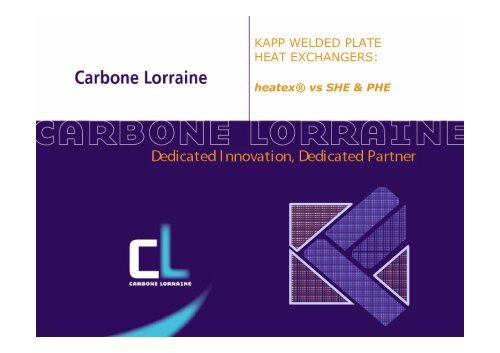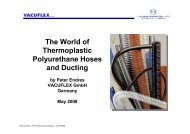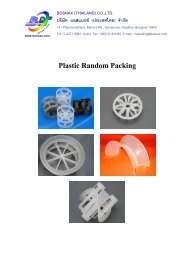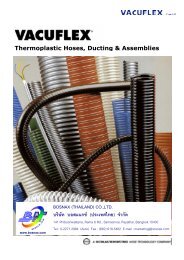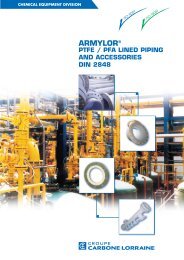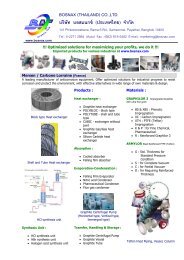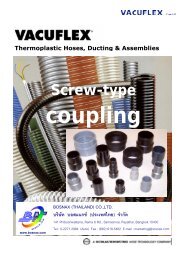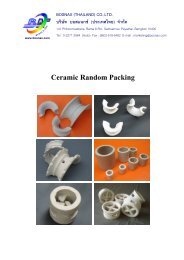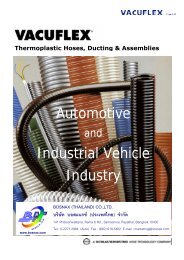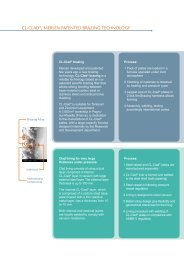KAPP WELDED PLATE HEAT EXCHANGERS:
KAPP WELDED PLATE HEAT EXCHANGERS:
KAPP WELDED PLATE HEAT EXCHANGERS:
Create successful ePaper yourself
Turn your PDF publications into a flip-book with our unique Google optimized e-Paper software.
<strong>KAPP</strong> <strong>WELDED</strong> <strong>PLATE</strong><br />
<strong>HEAT</strong> <strong>EXCHANGERS</strong>:<br />
heatex® vs SHE & PHE
Heatex® vs Spiral – Range 1/3<br />
� Available with dimpled,<br />
studded and corrugated plate<br />
� Spacing:<br />
– Plate side from 3 to 10 mm for<br />
dimpled HXE, 6 to 25 mm for<br />
studded HXS, 5 mm for<br />
corrugated HXC<br />
– Frame side from 3 to 40 mm,<br />
free gap HXE<br />
� Plate dimension, from 150x150<br />
mm (HXE15) up to 1500x1250<br />
(HXE150/125)<br />
� Plate thickness:1.2 to 2.5 mm<br />
� Number of plates:10 to 200<br />
� Total area: 0.6 to 750 m²<br />
� Available with studded plate<br />
� Spacing:<br />
– From 5 to 50 mm on both<br />
side<br />
� Coil dimension, from 150 to<br />
2000 mm, max. body<br />
diameter 3000 mm<br />
� Coil thickness: 2.0/6.0 mm<br />
� Number of coil: 2 or 4<br />
� Total area: 1.0 to 500 m²
Heatex® vs Spiral – Range 2/3<br />
� Design pressure: -1/35 bar<br />
� Design temperature: -40/500°C<br />
� Material:<br />
– AISI304L/316L/904L<br />
– Duplex SAF22-05/SAF25-07<br />
– Ni alloy C276/C22/C2000<br />
– Titanium (forecast in 2009)<br />
– Tantalum<br />
� Design code:<br />
– PED97/23/CE<br />
– AD2000<br />
– ASME<br />
– SQLO<br />
� Design pressure: -1/20 bar<br />
� Design temperature: -40/500°C<br />
� Material:<br />
– AISI304L/316L/904L<br />
– 254SMO<br />
– Ni alloy C276/C22/C2000<br />
– Titanium<br />
– Monel<br />
– Incoloy 825<br />
� Design code:<br />
– PED97/23/CE<br />
– AD2000<br />
– ASME<br />
– SQLO
Heatex® vs Spiral – Range 3/3<br />
� Plate concept: frame plate (HXS<br />
& HXC) and pressure plate<br />
available (HXE)<br />
� Stress rate & elongation:<br />
– HXS: no elongation neither stress<br />
on plate profile, bending edge<br />
10%<br />
– HXE: dimpling & bending max.<br />
10%<br />
– HXC: 35%<br />
� Mechanical cleaning:<br />
– HXE: extremely easy on free gap<br />
side, difficult on plate side<br />
– HXS: easy on both side<br />
– HXC: not possible<br />
� Plate concept: frame plate<br />
� Stress rate & elongation: Low<br />
� Mechanical cleaning:<br />
– On both side but with blind<br />
channel
1. Shape comparison<br />
Heatex® Dimple Type vs Spiral Type<br />
Dimple(Embossed) Type<br />
- One is Dimple/Other is Free Gap<br />
- More Compact (m2/m3) = 150<br />
Spiral(Studded) Type<br />
- Both side = Stud<br />
- More bigger (m2/m3) = 100
2. Plate comparison<br />
Dimple(Embossed) Type<br />
- Intensification : 2 to 6<br />
- Forming on Plate<br />
- Spot welding between Two Plate<br />
(withstand the pressure)<br />
- no limitation on flowrate<br />
Heatex® Dimple Type vs Spiral Type<br />
Spiral(Studded) Type<br />
- Intensification : 1.5 to 3<br />
- Stud welded on Plate<br />
- No setting between Two Plate<br />
- Flowrate limitation (max. coil 2<br />
meters x spacing 25 mm)
Dimple(Embossed) Type<br />
- Nusselt Number(Turbulent flow)<br />
Heatex® Dimple Type vs Spiral Type<br />
3. Technologies Comparison<br />
A x 0.023Re^0.8Pr^0.33<br />
A = 2/6<br />
-> More easy to make Turbulent flow<br />
-> More efficient<br />
Spiral(Studded) Type<br />
- Nusselt Number(Turbulent flow)<br />
A x 0.023Re^0.8Pr^0.33<br />
A = 1.5/3.0<br />
- Lower tubulence
Heatex® Dimple Type vs Spiral Type<br />
Plate pack is made as a shell and tube heat<br />
exchanger bundle:<br />
- dimpled plates are fitted into a end<br />
connecting plate as tube in tube sheet<br />
-Plate replacement possible as in a shell<br />
and tube HE<br />
- Repair possible as in a shell and tube HE<br />
- SHE consist of two parallel sheet-metal<br />
ribbons that are coiled in such a way as to<br />
form two separate channels. Welded-in<br />
spacers pins, the heights of which correspond<br />
to the desired channel cross-section, ensure<br />
precise spacing of the coils.<br />
-- Leak occuring in central winding can not<br />
be repaired
Dimple(Embossed) Type<br />
Heatex® Dimple Type vs Spiral Type<br />
4. Maintenance Comparison<br />
- Easy mechanical cleaning on Process side<br />
as channel is free rectangular short cleaning<br />
length, can see across the channel<br />
- Easy to open doors on both side thanks to<br />
hinges<br />
- It can be possible to Mechanical cleaning<br />
under both pipe line connected. (one door<br />
without nozzles)<br />
- More easy to find defective part in visual<br />
if any (all welding accessible)<br />
- More easy to Repair for Welded part<br />
defective if any (one plate can be replaced)<br />
Spiral(Studded) Type<br />
- Mechanical cleaning difficult on both<br />
side, dues to spacers (studs) and<br />
channel is blind (not possible to see<br />
across, if coil is 1 meter, nearly<br />
impossible to clean at 1 m depth unless<br />
getting a very wide spacing (25 mm)<br />
which is not good for efficiency)<br />
- Need to dismantle nozzle before<br />
opening covers.<br />
- Difficult to find defective point if any<br />
- Repair not possible
Dimple(Embossed) Type<br />
- Good for Vibration shock<br />
- Good for external mechanical shock<br />
- No plugging risk because not contact<br />
point on process side<br />
- self venting and self draining<br />
Heatex® Dimple Type vs Spiral Type<br />
5. Operating Comparison<br />
Spiral(Studded) Type<br />
- Weak for Vibration shock<br />
- Weak for external&Internal<br />
mechanical shock<br />
-> It can be defective stud welded<br />
point & stud go through the next plate<br />
even though small mechanical shock.<br />
-Plugging risk due to studs<br />
- difficult to vent and drain due to<br />
winding coil
Heatex® Dimple Type vs Spiral Type<br />
Hinges for easy opening<br />
One door per channel<br />
without nozzle, easy<br />
cleaning<br />
1 cover per side, not posisble to see<br />
across the channel<br />
Need to dismantle<br />
nozzle for cover<br />
opening before<br />
cleaning
Heatex® vs Plate Heat Exchanger<br />
(GPHE)<br />
<strong>HEAT</strong>EX®<br />
PHE
Heatex® vs GPHE – Range 1/3<br />
� Available with dimpled,<br />
studded and corrugated plate<br />
� Spacing:<br />
– Plate side from 3 to 10 mm for<br />
dimpled HXE, 6 to 25 mm for<br />
studded HXS, 5 mm for<br />
corrugated HXC<br />
– Frame side from 3 to 40 mm,<br />
free gap HXE<br />
� Plate dimension, from 150x150<br />
mm (HXE15) up to 1500x1250<br />
(HXE150/125)<br />
� Plate thickness:1.2 to 2.5 mm<br />
� Number of plates:10 to 200<br />
� Total area: 0.6 to 750 m²<br />
� Available only with corrugated<br />
plate, gasketted type (GPHE),<br />
semi-welded (SWPHE) or free<br />
flow (FFPHE)<br />
� Spacing:<br />
– 2.6 to 4 mm for GPHE&SWPHE<br />
– 6.0 to 12.0 mm for FFPHE<br />
� Plate dimension, from 0.03 up<br />
to 4 m²/plate<br />
� Plate thickness: 0.4/0.8 mm<br />
� Number of plates:10 to 1000<br />
� Total area: 1.0 to 4000.0 m²<br />
GPHE<br />
SWPHE<br />
FFPHE
� Design pressure: -1/35 bar<br />
� Design temperature: -40/500°C<br />
� Material:<br />
– AISI304L/316L/904L<br />
– Duplex SAF22-05/SAF25-07<br />
– Ni alloy C276/C22/C2000<br />
– Titanium (forecast in 2009)<br />
– Tantalum<br />
� Design code:<br />
– PED97/23/CE<br />
– AD2000<br />
– ASME<br />
– SQLO<br />
Heatex® vs GPHE – Range 2/3<br />
� Design pressure: 0/20 bar<br />
� Design temperature: 0/150°C<br />
� Material:<br />
– AISI304/316<br />
– 254SMO<br />
– Ni alloy C276/C22/C2000<br />
– Titanium (Ti-Pd)<br />
– Ni 200<br />
� Design code:<br />
– PED97/23/CE<br />
– AD2000<br />
– ASME<br />
– SQLO
Heatex® vs GPHE – Range 3/3<br />
� Plate concept: frame plate (HXS<br />
& HXC) and pressure plate<br />
available (HXE)<br />
� Stress rate & elongation:<br />
– HXS: no elongation neither stress<br />
on plate profile, bending edge<br />
10%<br />
– HXE: dimpling & bending max.<br />
10%<br />
– HXC: 35%<br />
� Mechanical cleaning:<br />
– HXE: extremely easy on free gap<br />
side, difficult on plate side<br />
– HXS: easy on both side<br />
– HXC: not possible<br />
� Plate concept: frame plate<br />
� Stress rate & elongation: 40%<br />
� Mechanical cleaning:<br />
– GPHE/FFPHE: by dismantling<br />
frame, in most of the time<br />
gaskets are damaged and need<br />
to be replaced<br />
– SWPHE: only one side
Punching allow low stress forming,<br />
dimpled plates are spot welded<br />
together to form a channel which<br />
withstand the pressure.<br />
Heatex® vs GPHE– Fabrication 1/3<br />
Pressing give a chevron profile to<br />
every plate which can get different<br />
angle, wave pitch or depth<br />
Gasket allows tigthening with<br />
external and avoid fluid mixing (ring<br />
gasket)
Heatex® vs GPHE– Fabrication 2/3<br />
Every single dimpled plate channel<br />
(rectangular tube) is inserted into a end<br />
connecting plate (tube sheet)<br />
Dimpled plate 1.5/2.0 mm thick form the<br />
plate side with the « plate sheet », free<br />
gap between plate form the rectangular<br />
tube on frame side<br />
Plates are fitted into a frame made of a<br />
fixed plate (1), a removable rear plate(2).<br />
Plates are sliding on a up guide bar (4).<br />
Plate pack is tightened through bolts (7)<br />
Corrugated plates 0.6/0.8 mm thick<br />
form channel with contact points
Heatex® vs GPHE– Fabrication 3/3<br />
Plate pack consist in dimpled<br />
plate welded on the “plate<br />
sheet”, every plate is<br />
independent, free of expansion<br />
(U plate design thermal<br />
gradient higher then 200°C).<br />
Every channel can be repaired<br />
or replaced<br />
Every fluid flows between two plates, in<br />
counter current flow, with generally parallel<br />
distribution, inlet on the up port hole, outlet<br />
from the down port hole, and inversely for the<br />
other fluid.
Heatex® vs GPHE<br />
Strengths & weaknesses<br />
�Easy mechanical cleaning from the ideal<br />
free gap rectangular channel on HXE type<br />
to the studded channels on HXS.<br />
�No plugging risk, spacing up to 40 mm<br />
�HXE type can offer one channel<br />
completely free gap, without any contact<br />
points nor retention which is requested<br />
for cGMP plants (FDA request)<br />
�Low stress rate for HXE and HXS<br />
avoiding upgrading material for pitting<br />
corrosion<br />
�Good thermal fatigue resistance<br />
particularly thanks to U plate concept<br />
�Thermal expansion possible as every<br />
plate is independant and even free with U<br />
plate concept<br />
�All welding are accessible, plate sheet<br />
to plate channel easy to repair<br />
�Plate channel can be replaced one by<br />
one.<br />
�HXE & HXS has lower efficiency<br />
compared to GPHE<br />
�HXS very expensive compared GPHE<br />
�Plugging risk due to contact points<br />
�Retention due to contact points (leak<br />
point for FDA)<br />
�High stress rate on the plate,<br />
increasing the corrosion risk (pitting!),<br />
plate 0.6 mm – 40% = 0.36 mm!!!<br />
�Limited pressure and thermal fatigue<br />
resistance due gaskets<br />
�Temperature limit use 150°C<br />
�Pressure limit use 18 bar<br />
�High maintenance cost (spare parts)<br />
�High thermal efficiency<br />
�Very price-competitive<br />
�Extension possible<br />
�Cleaning possible by dismantling the<br />
frame and removing plates
Heatex® vs GPHE<br />
Case study: the problem<br />
� Customer Rohm&Haas<br />
– Fluid to be cooled: Visquous emulsion<br />
(300 mPa.s) with aromatics contents<br />
– Service side: cooling water at 27°C<br />
– Duty: 1025 kW<br />
– Hot side: from 95°C down to 45°C
� <strong>HEAT</strong>EX ® HXE50 – 70 m²<br />
� 140 plates<br />
� Kvalue= 478 W/m².°C<br />
� Price= 59000 €<br />
� Weight= 3200 kgs<br />
� Plate pack AISI 316L<br />
� Frame CS lined<br />
� Doors gasket PTFE on process,<br />
EPDM on water<br />
720 mm<br />
Heatex® vs GPHE<br />
Case study: Solutions<br />
2050 mm<br />
� FH40 – 30.8 m²<br />
� 78 plates<br />
� Kvalue = 1060 W/m².°C<br />
� Price= 9500 €<br />
� Weight= 610 kgs<br />
� Plates AISI 316<br />
� Gaskets Viton<br />
� Frame CS, rubber liner port hole<br />
560 mm<br />
1579 mm
Heatex® vs GPHE<br />
Case study: Results<br />
� Customer preferred solution:<br />
GPHE FH4O (under budget constraint)<br />
� Every 2 months opening for cleaning<br />
� Production losses not estimated<br />
� Maintenance cost: 2400 €<br />
� Set of spare part gaskets: 8800 €<br />
� Yearly maintenance cost: 67200 €<br />
� Conclusion: Heatex pay back 10 months!!!


